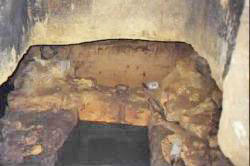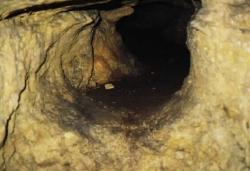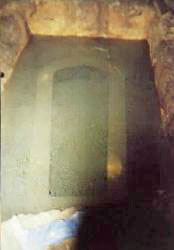|
The Shaft, The Subway
& The Causeway
Part 9
Phenomena Magazine - "Tunnel Talk"
article
In early 2004, an article written by Nigel Skinner-Simpson appeared
in issue 2 (Jan/Feb 2004) of Phenomena Magazine. The text of the
annotated version of the article is given below. The published
version did not contain the references due to space limitations. The
photographs first appeared in "Giza The Truth" by Ian Lawton & Chris
Ogilvie-Herald © 1999, used with permission of the authors.
On the night of the 2nd March 1999 as the FOX "Opening The Lost
Tombs" TV special drew to a close Dr. Zahi Hawass introduced the
world to his latest find - a symbolic "Tomb of Osiris" located deep
below the causeway linking the Valley Temple and the pyramid of Khafra. According to Dr. Hawass it is also the place that Herodotus
was told about when he visited the Giza plateau 2,500 years ago.
Stories had been circulating about it for some time. At the A.R.E
[1] conference held at Virginia Beach in August 1998, Dr. Hawass
described his new discovery as a shaft over 100 feet deep opening
into a pillared hall in the middle of which was a huge sarcophagus
submerged in water. This was the first opportunity for the world to
actually see what he was talking about.
Contents
Return to Main Index
page 1│ page 2│ page 3│ page 4│ page 5│
page 6│
page 7│
page 8│ page 9
Chambers In The Sand
The shaft actually consists of three levels.
-
The first level is
reached via a 9 meter vertical shaft cutting through the causeway
and down through the roof and floor of a subway passing beneath
it.[2]
-
The entrance is through an opening cut into the north wall of
the shaft, the room being empty and devoid of any decoration.
-
Cut
into the floor at the northern end is another shaft descending 14
meters into the rock. It ends on the south side of a large chamber
with seven side-chambers; three cut into the west wall, three into
the east and one into the north.
-
A large sarcophagus occupies the
centre side-chamber in the west wall, and another in the
northern-most side chamber in the east wall.
Dr. Hawass has dated
this level to the time of the twenty sixth dynasty, around 500 B.C.,
based on the style of the pottery that he found. Cut into the floor
of the southern-most side-chamber in the east wall is another shaft
descending 10 meters to the third level.
An astonishing site greets the eye as
the chamber comes into view.
-
In the centre is a rectangular
enclosure surrounded by water except for a connection leading to it
from the eastern side of the chamber.
-
At each corner the remains of
a pillar can be seen.
-
The area inside the enclosure is also full of
water beneath which a sarcophagus sits submerged.
-
Dr. Hawass
believes this level to be a symbolic "Tomb of Osiris".
-
In the time
of the New Kingdom, the Giza Plateau was known as "The House of Osiris, Lord of the Underground Tunnels".
-
Dr. Hawass found evidence
of the hieroglyphic sign "Pr" meaning ’place’ or
’house’ before the
pillars to the east of the sarcophagus.
-
The sarcophagus itself
represents Osiris resting surrounded by water, the four pillars
forming his house or palace.
-
From the size of the sarcophagus and
the style of pottery found, Dr. Hawass dated the third level to the
New Kingdom.
So is this a new discovery? Dr. Hawass is undoubtedly the first to
excavate the third level but as he points out in his lectures on the
subject the location has been known about for many years. Professor Selim Hassan excavated in this location during his sixth season at
Giza in 1934/35. The Daily Telegraph of 4th March 1935 carried a
report of his find much as we know it today, although it describes
the third shaft as,
"ending in a colonnaded hall in which three
basalt sarcophagi were found".[3]
In "Excavations At Giza"
vol. 5 Hassan says of the third shaft,
"Through the clear water we can see
that it ends in a colonnaded hall, also having side chambers
containing sarcophagi".[4]
The references in these reports to
additional sarcophagi and side chambers no doubt arise from his
restricted viewpoint. Hassan tried to pump out the water for four
years without success, the flooded third level keeping its secrets
for the time being. Later on, the water was pumped to the surface
for use in the local vicinity.[5]
Go
Back
Enter Boris And The ARE
|
Looking towards
the west end of the central enclosure
 |
The next major development happened in
November 1996 when a documentary filmmaker named Boris Said visited
the location. Said was working with a team headed by Dr. Joseph Schor of
The Schor Foundation. Schor had obtained an annually
renewable five-year license to conduct acoustic and radar surveys on
the Giza plateau under the direction of Florida State University.
Said had entered into a joint-venture with Schor to film the work
for a new documentary. On a previous visit in 1992, Said found the
third level full of water but now the water had dropped by as much
as five meters.
The sight he saw was very different to the one shown
to the world on the FOX TV Special. A pile of muddy debris extended
from the eastern side of the room and tapered off at the sides into
the water. Towards the centre the partially buried enclosure also
full of water broke through the debris. Said’s crew scraped away at
the dirt on the chamber’s eastern side to clear a flat area for the
camera tripod. It quickly became apparent that a smooth hard surface
was becoming exposed. As more was revealed, a dark sarcophagus lid
came into view.
The way Said tells it[6] nothing more happened until February 1997
when team member Dr. Thomas Dobecki investigated the find using
ground-penetrating radar. This indicated the lid to be around thirty
inches thick. Two and a half meters below the lid it detected a two
and a half meter wide anomaly with what looked like a domed ceiling.
The anomaly descended at a twenty five degree angle and headed in
the direction of the Sphinx. This was exciting news because in
April/May 1996 Dobecki’s radar detected a possible tunnel
approximately two meters wide and three meters below the surface
emerging from beneath the rump of the Sphinx and heading in a
westerly direction under the causeway towards Khafra’s pyramid.
According to Said, he rushed off to tell
the Egyptian inspector about the findings only to be told that the
team had no right to operate the radar equipment because his permit
only gave the right to film. Furthermore, Said says he only then
found out that Schor’s permit had been revoked at the end of 1996.
Schor and Said parted company with Schor eventually taking out a
lawsuit against Said for breach of confidentiality. It is worth
noting that Schor’s permit was not actually revoked and that Said’s
recollection of events was not always consistent.[7] Would the
subsequent excavation by Dr. Hawass have taken place had it not been
for the above events? Dr. Hawass simply states that he decided to
excavate the location because he found out that the water level had
fallen.[8]
Go
Back
The House Of Osiris?
Is this a symbolic Tomb of Osiris? The attribution seems to depend
on finding evidence of the hieroglyphic sign "pr" meaning "house" or
"palace" and the central enclosure being surrounded by water
suggesting the primeval mound of creation. The New Kingdom dating -
the time when Giza was known as the "House of Osiris, Lord of the
Underground Tunnels" - is based on the size of the sarcophagus and
the style of pottery found inside the shaft.[9]
Regarding the sign "pr", Dr. Hawass writes, "We found the
hieroglyphic sign which means house or palace on the ground to the
east of the sarcophagus",[10] and in an interview with Andrew Bayuk,
webmaster of "Guardian’s Egypt" and Hawass’ own website, Dr. Hawass
points between the two eastern pillars on a model and states "there
is evidence at the beginning before these two pillars of the
hieroglyphic sign "Pr" which means "place".[11] This suggests that
the sign is physically carved in the rock to the east but an
Archaeology magazine article reports him saying it is formed by the
shape of the pool surrounding the pillars.[12]
|
Going nowhere
inside the tunnel rumoured to lead to the Great Pyramid.
 |
The same report also mentions that the
pool could well be the result of a rise in the water table rather
than being an original feature.[13] Chris Ogilvie-Herald, co-author
of "Giza: The Truth" also doubts that the chamber intentionally
contains water. He points to the rough excavation or tunnel said to
have been cut in the northwest corner in the late period[14] as the
original culprit and thinks it is either a natural fissure or an
underground watercourse that broke through the wall some time after
the chamber’s construction. He cites the undercutting of the sides
of the tunnel as clear evidence of water erosion.[15]
The Giza
plateau is known to have been subject to rainfall in ancient
times.[16] Could some of this water have entered the underground
water courses and faults riddling the Giza plateau subsurface and
ended up in the third level? In 1999, Dr. Hawass investigated the
tunnel and found that it ends after four meters.[17] Unfortunately,
we do not know how it ends in the rock or if there was ever some way
for water to get through. The presence or absence of tool marks
would help to confirm the tunnel’s origin one way or another.
Another element of the New Kingdom dating is the size of the
sarcophagus. In his book "Death In Ancient Egypt",
A. J. Spencer
describes how some sarcophagi of the twenty sixth dynasty were
similar in style to the royal sarcophagi of the New Kingdom, being a
rectangular chest with the head end rounded and sides that converge
slightly towards the foot. Could the sarcophagus actually be a copy
of the New Kingdom style as illustrated by Spencer?[18] There is
also a striking similarity between the sarcophagus lid and one shown
in Spencer’s book under the caption "Plans and sections of the lids
of Late Period stone sarcophagi" where he is again dealing with the
question of late copies of New Kingdom sarcophagi.[19]
Go
Back
Deeper Shafts
|
Submerged
sarcophagus in the central enclosure.
 |
Dr. Hawass is quite certain about the
third level’s New Kingdom dating even though the only access is via
the second level which he dates to the much later time of 500 B.C.
In his interview with Andrew Bayuk, he says about the second level,
"I dated this level to 26th Dynasty, 500 BC. based on the pottery
style and that this second shaft was cut later."
When questioned
about bones being found in the third level, Dr. Hawass explains,
"Because they used this in the Late Period also for burials". Andrew
asks, "So then you believe this third level to be originally from
the New Kingdom and then later used for burial in the Late Period?"
to which Dr. Hawass replies "Yes".[20] However, the cutting of the
second level at a later period has been questioned because the shaft
to the third level is cut into the floor of one of the second
level’s sidechambers.[21]
From the issues raised above, could the third level be something
other than a symbolic New Kingdom "Tomb of Osiris" - perhaps a 26th
Dynasty tomb for a high-ranking official? What about the artifacts
that Dr. Hawass found and dated to the New Kingdom? One final
question - In the television documentary "Mysteries of the Pyramids
- Live!" broadcast in 1988, Dr. Mark Lehner visits the third level
and throws a pebble into the water, saying that the point of impact
marks the spot where two more shafts go deeper still.[22] Have the
shafts finally been investigated? Maybe there is more to be told…
Go
Back
List of References...
[1] Association for Research and
Enlightenment
[2] The subway was originally constructed to connect the
necropolis of Khufu with that of Khafra and a similar subway can
be found cut in Khufu’s causeway.
[3] See
shafted3.htm#Telegraph for article
[4] "Excavations At Giza Vol. 5 1933-1934" by Selim Hassan with
the collaboration of Mahmoud Darwish, Cairo Government Press,
Bulaq 1944, p193, see
shafted.htm#Evidence for text.
[5] J. J. Hurtak stated on the Laura Lee Radio Show in March
1999, that the ladders and pumping equipment were installed in
1947.
[6] "Behind The Scenes With The Magical Eye Team On The Giza
Plateau" video account. Note that this disagrees with other
accounts - see note 7 below.
[7] In an interview on the Art Bell Radio Show, Said said that
the discovery of the sarcophagus lid and the radar investigation
both took place in February 1997, This has been confirmed to me
as the correct date by a team member who was present when the
lid was uncovered.
[8] See Guardian’s Spotlight Interview 2000 at
http://www.guardians.net/spotlite/spotlite-hawass-2000.htm
[9] See Guardian’s Spotlight Interview 2000 at
http://www.guardians.net/spotlite/spotlite-hawass-2000.htm
[10] Egyptair Horus magazine July/September 2000 p16.
[11] See Guardian’s Spotlight Interview 2000 at
http://www.guardians.net/spotlite/spotlite-hawass-2000.htm
[12] Archaeology Sept/Oct 2000 edition p31.
[13] Archaeology Sept/Oct 2000 edition p33.
[14] Egyptair Horus magazine July/September 2000 p16.
[15] See Giza: The Truth by Ian Lawton & Chris Ogilvie-Herald,
plate 49.
[16] Although rare, this has persisted into the modern era. See
"Discoveries in Egypt, Ethiopia and the peninsula of Sinai in
the years 1842-1845…" by Richard Lepsius, p27 for an account of
a flash flood at Giza on 2nd January 1843. (BL shelfmark
RB.23.A.5430)
[17] Arqueologia magazine interview with Dr. Hawass (in spanish).
[18] "Death In Ancient Egypt" by A. J. Spencer p187, see also
fig.74 p188.
[19] "Death In Ancient Egypt" by A. J. Spencer p191.
[20] See Guardian’s Spotlight Interview 2000 at
http://www.guardians.net/spotlite/spotlite-hawass-2000.htm
[21] Second level east side, southernmost sidechamber, see
Archaeology Sept/Oct 2000 edition p33.
[22] Atlantis Rising issue 15 "The Search for the Giza Hall of
Records" p56.
|

